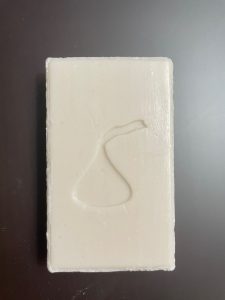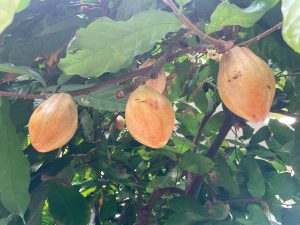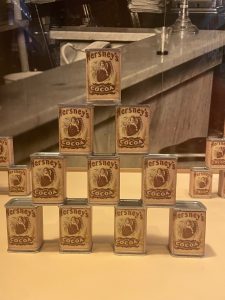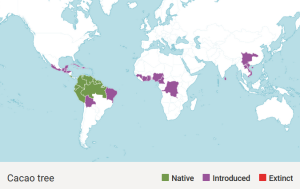
I have always had a sweet tooth. While some folks prefer their sweetness in fruit or fruity candy, my go-to has always been chocolate. So, you can imagine my delight upon learning our national meeting for Extension natural resource agents would be held in Hershey, Pennsylvania. I just returned from the meeting last week, and got a kick out of all the Hershey kiss-themed décor at our conference center, hotel rooms, and throughout the city. Even the shampoo and soap had cocoa in them!

Chocolate is a serious business, though—from its beginnings as a ceremonial drink for the Mayans and Aztecs—to the multi-billion-dollar industry it is now. Like many products, it literally takes contributions from the whole world to make chocolate. I was rather fascinated to learn the origins of the chocolate-making process while visiting the Hershey Museum and Gardens.
Chocolate starts with the cacao tree (Theobroma cacao) and its beans. While native to the Amazonian region of South America, it can grow in nearly any equatorial region and is now predominantly farmed in West Africa. Cacao farms consist of leafy green trees, so they look more like rainforests than the open fields we are accustomed to in agriculture.

Interestingly, the cacao tree grows its flowers directly on the main trunk, exhibiting “cauliflory” just like the Eastern redbuds I highlighted a few weeks ago. The tree’s fruit, called pods, are the size and shape of smallish footballs. Inside are the cocoa beans, covered in a gelatinous white pulp that is also edible. The pulp has been described as having a “tropical” flavor reminiscent of mango, lychee, or peach, and is used in some places for jams, ice creams, and juices.

Most of us are more familiar with the cocoa beans. Hershey, the 5th largest producer of chocolate in the world, started out using nearly every part of the cacao pod. After the seeds were removed, dried, and crushed for the chocolate-making process, they were separated out into “chocolate liquor” and cocoa butter.

The liquor is used in the actual chocolate-making process, and cocoa butter has been used over the years for products like soap, lotion, and shampoo. Early in the Hershey company’s history, they crushed the pods into mulch and sold it to gardeners.

Each tree grows about 30 pods per year. According to the Hershey Museum’s “Chocolate Math” curriculum, each of those pods contains 30-50 beans. To make a pound of chocolate, you need 500 beans—so one average cacao tree will yield approximately 2 pounds of chocolate. With worldwide chocolate consumption hovering around 16 billion pounds, that’s a LOT of trees.

There have been headlines lately about chocolate prices going up. This is due to several factors, but in large part to climate change. While the trees already grow in hot regions, the increase in temperature is also increasing evapotranspiration rates, drying them out faster. Drought conditions are devastating to these trees. Farmers are trying to adapt by growing the trees in the shade of larger trees or moving production up-slope to slightly cooler mountainsides. This, of course, requires clearing and planting in previously undisturbed rainforest, which can have a huge impact on wildlife and other ecosystem functions. Researchers are also working on newer varieties of cacao trees that will be able to survive the changing climatic conditions.
 14
14
